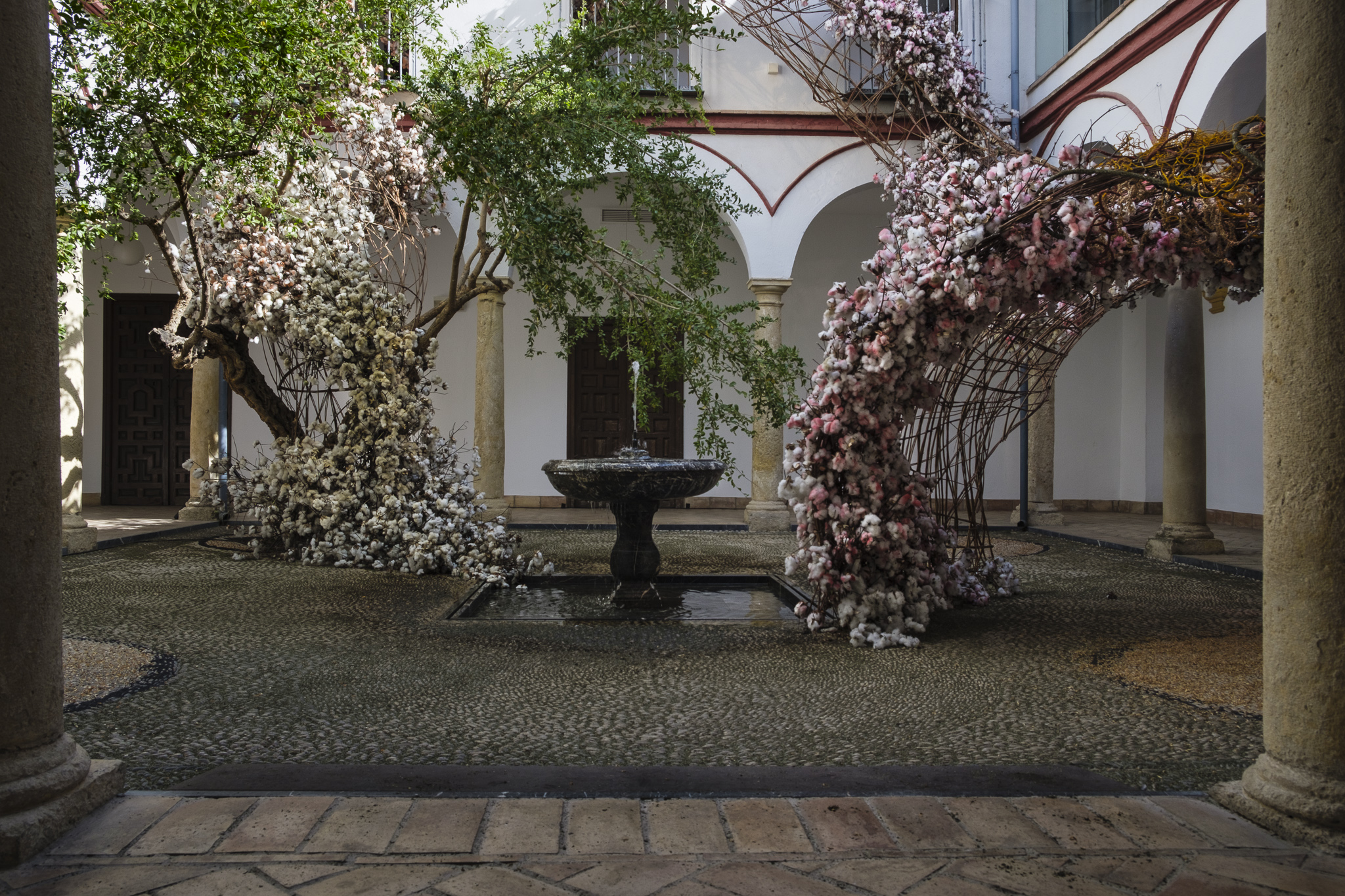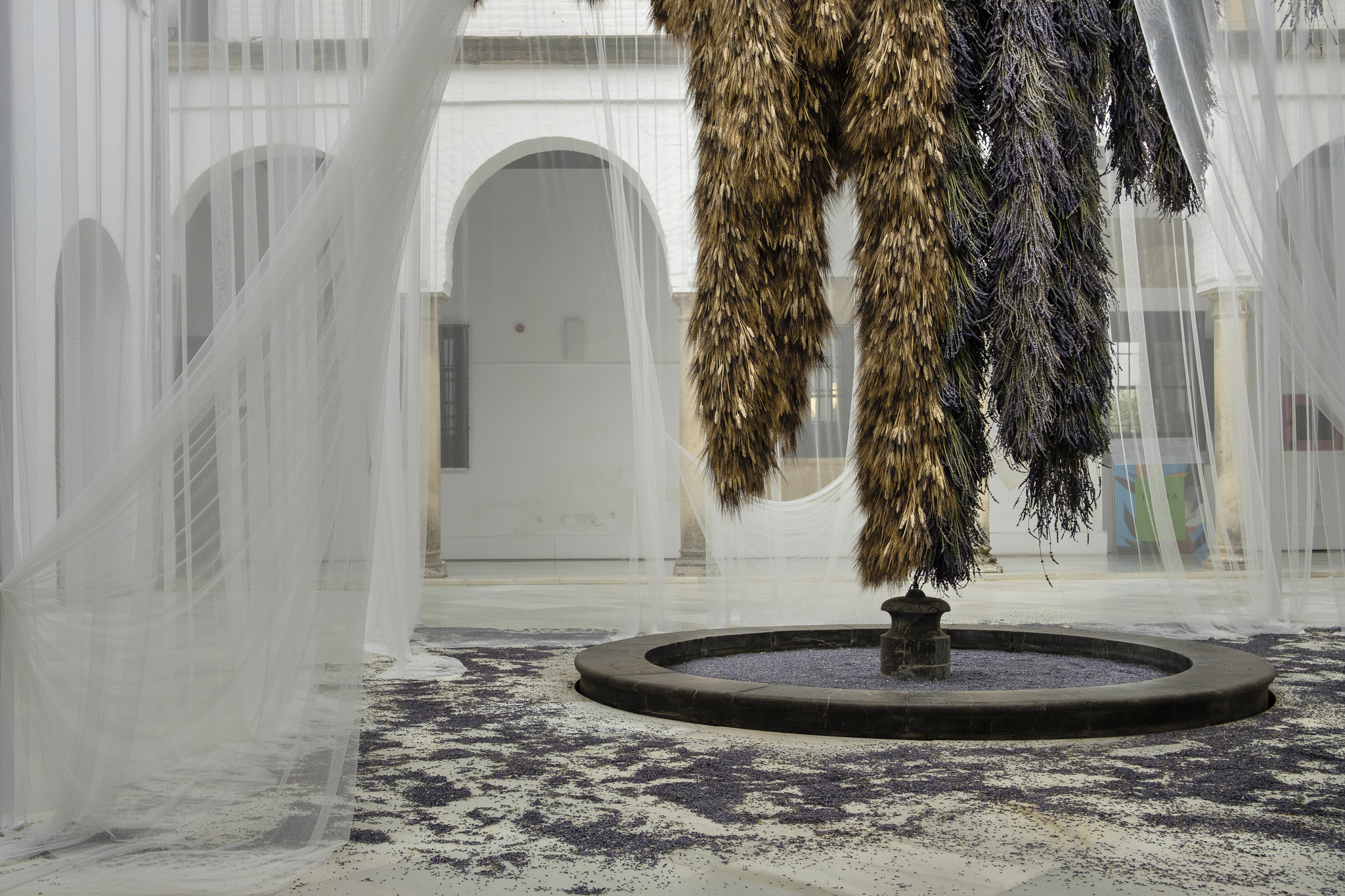Frenzied
FLOR MOTION
Movement in space and time. As soon as we enter Góngora House, the Flor Motion group introduces us into a tornado that elevates us and carries us away. Where to? To faraway lands, where cotton comes from – America, Africa, India – a plant that is now common in Andalusia but was not always there… Trepidante (Frenzied) is a dust cloud that picks up spices, seeds and nuances of light along its path and transports us to other places. To do this, endless hours of wicker handiwork were needed, as well as a strong passion for a flower that we haven’t seen at the Festival up to now: the simple yet lovely cotton flower.
CASA GÓNGORA
CALLE CABEZAS, 3 – CÓRDOBA
FROM 18TH TO 27TH OCT, 2019
11:00 AM TO 19:45 PM
PLANTS:
ALGODÓN Y MIMBRE.
OTHER MATERIALS:
TELA DE ALGODÓN Y TINTES NATURALES.

“Everything is movement and flows until it becomes part of vastly diverse cultures on a journey that, encompassing the senses, is more historical than geographical. Like cotton seeds, whose remote origins can be traced back to America, Africa and Hindu roots, it expands and is scattered in its search for land that will embrace it.
A subtle dust cloud that picks up spices, seeds and nuances of light along the way and, on this extended voyage, rises, undulating, to form alliances with diverse continents, cultures and groups. A colourful expression of nature in movement.
Trepidante (Frenetic) moves in and out, up and down throughout the patio of Góngora House to finally open up to viewers, exposing its entire structure. Trepidante (Frenetic) is made of woven wicker and cotton picked from the region’s fields. The entire piece is coloured and scented with the tones and aromas of spices that once were an identifying feature of the city of Cordoba”. Flor Motion
The Museum of Botanic Memory
LISA WAUD
Welcome to the future. We are in what might be a museum that will someday explain to people what the patios of Cordoba were and the relationship that the people there had with plants and flowers. This US artist wants to awaken our sense of gratitude towards what we have now through nostalgia: nostalgia as seen from the future. To do this, she is asking viewers to forget about their cell phones and the rush of life, and to try and contemplate something they think they know, because only by hushing the whirlwind we live in can we become aware of the natural world we are losing.
MUSEO ARQUEOLÓGICO
PLAZA DE JERÓNIMO PÁEZ, 7 – CÓRDOBA
FROM 18TH TO 27TH OCT, 2019
11:00 AM TO 19:45 PM
FLOWERS & PLANTS:
ADIANTUM BRONZE VENUS, AESCHYNANTHUS, AGLAONEMA, ALOCASIA, ALOE, ANIGOZANTHOS, ANTHURIUM, AVE DEL PARAÍSO, BANKSIA, BEGONIA, CALATHEA, CELOSÍA, CRISANTEMO, ESPARRAGUERA, EUCALIPTO, GERANIO, GITANILLA, GLORIOSA, HELECHO, HELICONIA, HORTENSIA, LEUCADENDRON, MARANTHUS, MONSTERA, NERINE, OLIVO, ORNITHOGALUM, ORQUÍDEA, PANICULATA, PROTEA, PRUNUS, ROBLE, ROSA CENTAURA, SENECIO, SORGO, TILANDSIA, VRIESEA, ZAMIOCULCAS Y OTRAS.
OTHER MATERIALS:
BARRO, CINTA ELÁSTICA, HIERRO, MADERA DM, REPRODUCTORES MP3 Y TELA.

The Museum of Botanic Memory is a multi-sensory multi-gallery installation set in the future and created to induce gratitude as a journey through nostalgia. artist lisa waud aims to invoke a sense of acknowledgment and appreciation for nature in our present lives through the consideration of botanic memories in the context of a future history.
Inspired by Jenny Odell’s book,How to Do Nothing and the idea of attention-holding architecture: “the artist creates a structure of attention-holding architecture that holds open a contemplative space against the pressures of habit, familiarity, and distraction that constantly threaten to close it.”
I offer the Museum of Botanic Memory as an interruption to these pressures, encouraging visitors to consider spaces in our everyday lives—for córdobans, the patio—that we can return to and hold open, as well as protect, as we move into a future of a threatened natural world”. Lisa Waud
Fieldwork
MARY LENNOX
Ruby Barber always works from direct observation of nature. Last July she visited Cordoba and, on the way, discovered the lavender and wheat fields of La Mancha. Is it possible to transfer that two-colour image, which reminds Barber of Ellsworth Kelly’s abstract paintings, and that visual and aromatic experience to a patio in Cordoba? This Australian artist proves that it is. A strong advocate of biomimicry, nature as the source of ideas and solutions to the problems of humanity, only here did she find the beauty she was seeking for FLORA.
PALACIO DE ORIVE
PLAZA DE ORIVE, 2 – CÓRDOBA
FROM 18TH TO 27TH OCT, 2019
11:00 AM TO 19:45 PM
FLOWERS & PLANTS:
LAVANDA Y TRIGO.
OTHER MATERIALS:
CUERDA, HIERRO, HIERRO GALVANIZADO, PLÁSTICO Y TUL.

Fieldwork takes the audience to a Spanish summer landscape; a trip of the senses, an immersive experience and a minimalist homage to a specific place and time.
Fieldwork was inspired by our trip to Cordoba, during which we visited the iconic lavender fields of Brihuega. Every July, a sea of Lavendula stoechas bloom in full display, creating a swathe of purple monochrome that sends a sweet, calming scent into the air. Planted immediately adjacent to the Lavender fields are complementary fields of wheat that rustle gently in the breeze. The Lavender/Wheat duo is a classic union in European agriculture, and one that fully activates the senses.The colour combination is heady and brings to mind the poetic simplicity of American minimalist painters such as Ellsworth Kelly and his iconic two-colour abstractions.
The practice of fieldwork involves direct observation and gathering of raw data outside of a traditional workplace. Conducting fieldwork in the natural environment is deeply ingrained in Mary Lennox’s creative process. We invite our audience to experience the fields that inspired us for this installation and immerse themselves in an objective celebration of nature rather than a romantic imagining of a fictional landscape. Mary Lennox’s installation aims to present nature as veracity, not decoration, and endeavours to transport the visitor to the landscape where we conducted our study.
Alongside our recreation of the monochrome lavender and wheat fields, the site specific installation will include a hanging piece (Mary Lennox’s signature style) showcasing how a piece of design is directly inspired by nature.
This process, Biomimicry or bio-inspired design, involves the translation of knowledge obtained from the natural world into new applications and innovations. When using nature as inspiration we learn from a system that has developed resilience, adaptability and efficiency over countless millennia, not to mention that our planet that has organically created the most beautiful pieces of design ever made. Biomimicry is an extremely important mechanism for our future and goes far beyond aesthetics. This process needs to be the at the core of all innovation and we believe the implementation of repeated references to the natural world will provide inspiration for further strategies that may perhaps save our troubled planet”. Ruby Barber
Static Field
PHKA
Flowers travel too. Or rather, we make they travel. How does a flower experience the course of its “vertical” life, rooted to the ground, until it is placed horizontally in an art installation? Human beings travel in search of progress, personal growth; flowers, on the other hand, travel towards their end, an ending that, paradoxically, aims to display them in all their splendour: in bloom. As in strobe photography, PHKA’s installation speaks to us of movement simulating a moment frozen in time, featuring meticulous design work that fills the Chapel Courtyard with colour.

Instead of telling story about the trip of human being, a narration on life and journey of cut flowers is proposed. During their lifespan, they were grown, cut and delivered from one place to another; in order to be utilized by human during their most beautiful stage – full bloom; before getting abandoned. These ephemera are generally harvested and then handled in protective packaging to maintain the best condition and distributed to specific places. While trip for all of us means to go forward, experience new things which eventually make us grow in some way, trip of cut flowers is contradictory to be transported from origin to destination while remaining the same – a ‘freeze of time’.
Time freezing or ‘Stasis’ is interpreted and visualized by strobe photographs of moving flowers. Axial transposition would represent origin with vertical alignment, and destination with horizontal alignment. Each type of flowers would be installed in varying degrees. Due to its serenity and position as a final sequence, Courtyard of the Chapel will be a perfect site to portray the installation”. PHKA
Constellation
THIERRY BOUTEMY
Although he enjoys working with large amounts of flowers and colours, this time Boutemy has decided to create, in his own words, “a sensation of fragility and melancholy that is, doubtless, the source of my love for flowers”. His personal constellation. That makes this the most personal work yet by one of the most highly respected floral artists in the world. This French artist, who always has the wild landscapes of his childhood in Normandy in mind when creating his works, finds the roots of his thoughts in the darkness and in light projected on nature. And he does not hesitate to assert that flowers give him his greatest joy, but also quite the contrary.
DIPUTACIÓN DE CÓRDOBA
PLAZA DE COLÓN, 15 – CÓRDOBA
FROM 18TH TO 27TH OCT, 2019
11:00 AM TO 19:45 PM
FLOWERS & PLANTS:
CISSUS VERTICILLATA TREPADORA, CRASPEDIA, NARCISO DE OTOÑO, REGALIZ Y STHYPAS.
OTHER MATERIALS:
FOCOS LED, MADERA DM, MOQUETA, TELA Y TUL.

“We are in a patio, the central space, and the clock face with the stars, the celestial bodies, the mythology, the cosmos and the mystery of where we are.
Man has imagined these points of reference, which make him feel safe.
Therefore, I have decided to recreate a box in which I can reflect my universe and the way in which I perceive a manner of thinking that springs from darkness, where light brings life to the plant composition amongst birth, rebirth and death. Life.
The vegetation is composed of grasses, roots, bulbs, colchicum and clematis.
A body made of lichen and a sort of levitation or flotation within a plant cosmos.
Music is there to give it the mystery of a wandering, travelling, universe.
Although I usually enjoy working with more colours and flowers, I wanted to recreate a sensation of fragility and melancholy here, which is, doubtless, the source of my love for flowers; flowers, as I have often said before, are the reflection of our fragility and vanity for working with them in daily life. This feeling is reinforced for me: they give me my greatest joy, but also quite the contrary”. Thierry Boutemy
STAFF | FACEBOOK | INSTAGRAM | YOUTUBE | LEGAL NOTICE | PRIVACY POLICY | COOKIES POLICY |2017 | 2018 |INFO@FESTIVALFLORA.COM







